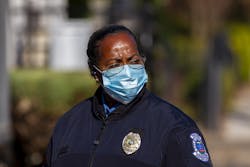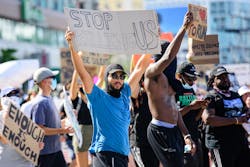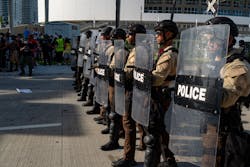Like the rest of the world, the law enforcement profession was glad to see 2020 end.
From the COVID-19 pandemic to civil unrest following the death of George Floyd, police departments, sheriff’s offices and other agencies spent much of last year navigating the perilous straits created by those events. All of which was coming at a time when communities were—and are still—struggling to staff their departments.
But 2021 was a new year, and that meant the problems of the previous year would fade away like an unwanted memory, right?
Wrong.
Law enforcement officers continued to deal with the ramifications of COVID and calls to defund the police in 2021. In fact, many of the issues that seemed unique to the previous year proved they had legs to last at least a year longer.
As 2021 ends, OFFICER Magazine spoke with police chiefs and sheriffs from around the country to discuss some of the challenges of the year that was and look at how much can change—and stay the same—over 365 days.COVID-19
Park City, Utah Police Chief Wade Carpenter remembers what it was like in those early days of the pandemic as COVID quickly spread through the tourist community.
“We had people coming here from all over the world, and so we initially had a spike,” says Carpenter, who also is the second vice president for the International Association of Chiefs of Police. The chief said that early outbreak led to heightened precautions for officers to ensure their safety. “We really were strict as it pertained to access with the public,” he says. “We did most of our briefings remotely, but every day I wanted my supervisors laying eyes on officers. They would actually be in their cars, and they would do lineup in the parking lot.”
“We checked officers’ temperatures every day,” he adds. “When they came on duty, we had a protocol that if someone had an elevated temperature, we sent them in for a COVID test.”
Eventually, the Park City community was able to get the virus under control, and the area saw the number of cases drop to some of the lowest levels in the state. That led to the slow reopening of the community in 2021, and the return of certain public events. “I was pleased to see these events coming back online in a responsible way,” says Carpenter. “I think people were being more cautious than they had been, but at that same time, I think now people have gotten to the point where they were frustrated being locked up and they now want to be out in public.”
But that light at the end of the pandemic came with its own challenges. As COVID cases dropped in some areas, the virus—and the precautions needed to stay safe from it—stopped being front of mind for some officers.
“We’ve had sort of a lull (in COVID-19 cases), and (officers) got very lax, and the delta variant came along, and we are right now going through a resurgence,” says Renville County, Minnesota Sheriff Scott Hable. “We did, in fact, lose one officer in corrections to COVID. But now we are going back to tell staff, you need to mask up, you need to social distance. So we’re starting to push that again.”
Beyond COVID protection, pandemic safety protocols have had another effect on departments.
“(The protocols) have made them more aware of other things, such as blood-borne stuff... and other sicknesses going into people’s homes,” says Cheswold, Delaware Police Chief Christopher Workman. “They’re becoming more diligent protecting themselves because of COVID.”
In 2021, however, the biggest COVID issue that the law enforcement community has had to handle has been officer vaccinations. In cities and departments around the country, battle lines are being drawn over vaccination requirements for law enforcement. In Chicago and Los Angeles County, lawsuits have been filed by police unions to stop vaccine mandates for officers. Officials in Seattle, San Diego and other cities have expressed their fears that mandates will led to massive officer shortages that could jeopardize public safety.“There’s a lot of blowback for the vaccine, probably a good 50% of officers, no matter where they’re at,” says Franklin County, Kansas Sheriff Jeff Richards. “Doesn’t matter if they’re small or big departments.”
Opposition to the vaccine and issues over medical privacy have created a minefield for law enforcement supervisors to delicately navigate. That’s meant finding a balance between respecting officers’ rights and still maintaining their safety. Sometimes, however, the virus itself has provided the most convincing vaccination argument for officers. “The majority of our staff decided to get vaccinated,” says Carpenter. “We had several who didn’t, and I would say maybe a third of the department that didn’t get vaccinated, probably half of those contracted COVID. And since that time, they were treated and got vaccinated, and the others followed suit.”
COVID’s biggest impact, though, has been the way it has ravaged the law enforcement community. In 2021, it became the leading killer among law enforcement officers, with over 715 officers dying from the virus since March 2020, according to the Fraternal Order of Police.
Despite those facts, some officers aren’t giving COVID the attention it deserves when it comes to personal safety.
“I think officers still continue to underestimate the virus… It’s kind of been a silent killer even though the numbers have been high,” says Chief Jacob Molitor of the Meskwaki Nation Police Department in Iowa, who also is the chair of the board of governors for the Small & Rural Law Enforcement Executives Association.
Police Reform
In November, Minneapolis voters rejected a sweeping police reform ballot measure, which would have replaced the city’s police department with a public safety agency more than a year after George Floyd’s death. While it’s too early to tell if the defeat is a barometer for the nation, the measure’s failure was an encouraging sign that the public might not be ready to throw out the baby with the bath water. “I think it was a positive move... and I think it’s a small step in the right direction to get us back on track,” says Sheriff Bill Brueggemann of Cass County in Nebraska, who called these type of legislative measures “knee-jerk reactions,” adding. “I’m not a fan of the reform bills out there because I think they’re a little bit over the line.”
One of Brueggemann’s objections to such bills is that, in some cases, they’re calling for changes that departments have been doing, such as eliminating certain chokeholds. He also is not in favor of sweeping reforms that don’t take the individual communities and departments into account.
“One size doesn’t fit all, and that’s what I think some are trying to force down our throats,” he says.” It’s a shame what happened (with the death of George Floyd). It’s wrong what happened, it never should’ve happened. And none of us would allow that to happen, and none of us would ever think it would happen at our departments. But that possibility is always out there.” He added that despite appreciation from certain segments of the public, law enforcement continues to struggle against the negative public image that has grown from national incidents and behaviors invovling a few officers. “Now we’re going to have to spend most of our careers to earn that trust back for something we never did wrong.”
Calls for sweeping police reforms aren’t unique to the past two years. But they have acquired a different flavor in the early 21st century. “I think these conversations have been happening for a very, very long time. Back from Rodney King, we had a spurt of police reform conversations,” says Cheshire County, New Hampshire Sheriff Eli Rivera. “Then we have another event where something like this happens. But I think with George Floyd and the power of social media and the new generation has basically stepped on the pedal and said we’re not stopping until we see something happen.”
Instead of bristling at that anger, some law enforcement leaders are using it to open a line of dialogue with those in their communities. When Sheridan County, Montana Sheriff Heidi Visocan heard about an upcoming protest in her community, she reached out to the organizer. “It really kind of changed her opinion of law enforcement because we were there to support her right to free speech and not kind of be ‘The Man’ and try to put everyone down. It led to really positive conversations with those people in my community.”Reaching out has also meant talking with the lawmakers responsible with crafting the nuts and bolts of any type of legislative reform. Carpenter said law enforcement officials in Utah have worked with legislators to create better bills that made changes without crippling departments.
The reform movement also reinforced to him how important it is for law enforcement to keep open the lines of communication between the community and lawmakers. One thing the pandemic eliminated were in-person events, which are vital for that police-community relationship.
“One of the most important things is how we tell our story,” says Carpenter. “Because if we’re not keeping our elected officials in the loop, that’s part of the problem... And that’s something I think we can always improve.”
Along with better communication with lawmakers and the community, some law enforcement officials have welcomed the spotlight that police reform has shone on mental illness. “We’ve all been crying about mental health for years now and finally something is being done, and we’re starting to see teams that come out and take over for us,” says Branch County, Michigan Sheriff John Pollack. “My patrol is not tied up with those kinds of things. From my perspective, it’s about time on that.” For Rivera, reforms and the difficult conversations that accompany them aren’t necessarily bad. The fear is that talks of defunding the police will move forward without thinking about how such a move will work.
“I think we need to understand that and look at these challenges that are before us It’s unfortunate that it took a George Floyd incident to get us to where we’re at right now where people are pushing for more police accountability, transparency, changes in ways we handle the mental health concerns in our community. And yes, Minnesota voted down the defunding of the police department, but what happens is any time they talk about defunding something it ends up in the lap of the police department … and we end up picking up the slack. And now we’re saying you’re thinking of defunding the police or something like that, who’s going to pick up that slack? Do you have a plan for that?
“So I think that conversations are now at the front of our communities and they understand that if we’re going to defund the police… we want to make sure we do it right, not just defund them and still require them to do what they’ve been doing because that’s not going to work,” he adds.
Officer Safety
It’s safe to say that it has become more dangerous for police and law enforcement officers. According to the FBI, attacks on law enforcement increased by 7% in 2020, and while this year hasn’t seen the same number of violent protests like last years, officers were still being targeted and ambushed at an alarming rate.
“I think officers have become more vigilant of their surroundings because of it,” Rivera says. “I think nowadays, we’re going to try to pair up, be more vigilant of the surroundings, know exactly where you’re going and be prepared for the unknown.”
But pairing up on patrols isn’t feasible in departments struggling to keep the minimum amount of officers on the street. “We’ve talked about two deputies going out on a call, but we just don’t have the staffing to do a whole lot of things different,” says Richards. “So we make sure we have in-cameras functioning, maintain radio contact, stuff that we’ve done for years. But as far as any additional protocols, we still have a job to do and we still have a limit to have to do it with.”
In the face of staffing shortages, departments try to focus on other areas to help out officers on the street. Having dispatchers gather more complete information from callers and making sure officers have the proper gear to protect themselves are measures that can help when bodies aren’t available. “What we have tried to do is increase our equipment,” says Pollack. “We make sure staff has the latest equipment to respond with, knowing that they’ll be responding either by themselves or in limited numbers.”
In the wake of last year’s unrest, preparation has become a watchword for departments. One of the things that last year’s riots reinforced to Carpenter was the importance of establishing good communication with the departments in the surrounding communities, as well as with state and federal agencies before civil unrest happens.
“It’s a very different climate now where we’re constantly making sure we have daily or weekly lap-over meetings with our neighboring departments to make sure we’re prepared for one of these protests, demonstrations or a riot,” he says.
Recruiting & Retention
On the surface, Carpenter was in an enviable position as a chief as the year started. Utah’s and Park City’s economies were doing well, and he had money to hire new officers at competitive wages.
The first problem: Departments throughout the state were in the same situation, and those chiefs had plans for attracting the best and brightest. What’s erupted, according to Carpenter, has been a wage war among agencies to try to woo recruits.
“What’s happened, at least in our state, is that the wages rose with the loss of officers almost 30% in the last six to eight months, so we’re all competing for the same pool of officers,” he says. “It’s really become a bidding war, where agencies are trying to come up with hiring bonuses, better benefits, increased wages, education reimbursement, anything they can think of that’s going to lead to hopefully retaining officers and drawing new officers to their agencies, which leads to a deficit of officers throughout the state. Some officers are basically moving from agency to agency depending on who has the highest wages, which has created a real problem.”
Outside of Utah, departments affected by vaccine are starting to see some of their officers looking to join police forces in other states. In fact, a handful of applicants from officers facing termination over a vaccine deadline have popped up on New Hampshire Sheriff Rivera’s desk.
The second problem for Carpenter—and for other chiefs and sheriffs—when it comes to filling openings: The pool departments are drawing from for recruits is becoming more shallow by the day.
“What’s happened is there are only a finite number of officers coming into the profession, and like I said, we’ve lost well over 1,150 officers in the state right now, and other states are much higher than that,” he says. “There’s just not a desire for young people to get into the profession.
“Officers have left the profession because they were concerned about the impact these movements may have on their protections—such as qualified immunity— that are necessary for officers who are acting in good faith. It’s been a real problem,” he adds. “There’s been this chilling effect on new officers coming into the police profession and also we’re not seeing the younger officers staying in the profession as long, so that’s a concern.”
And finally, Carpenter’s third hiring and retention problem: retirement changes. State lawmakers had changed retirement benefits from 50% after 20 years to 37% after 25 nearly a decade before the pandemic. This was recently changed to 50% after 25 years, but that still hasn’t been enough to entice new applicants or retain some existing officers.
“We’re having a hard time filling that void with new officers because they’re not wanting to work their extra five years to reap their retirement. We anticipate that we’ll need some changes legislatively for Utah law enforcement agencies to hire and retain new officers because there are jut not that many officers willing to stay in the profession with cuts in the retirement system.”
The lingering effects of a chaotic 2020 also have left their mark rank and file, with many suffering burnout or struggling with mental health issues. That situation has been even more acute for smaller departments that have less of a staffing safety net.
“When we hire people in law enforcement, we know we have a pretty good person because they’ve gone through an extensive background check and psychiatric evaluation, so we know they’re about as solid as they can be when they come on,” says Richards. “Unfortunately, as we know, sometimes the job breaks people and we want to make if we break them, we fix them. That’s kind of the philosophy that we’ve had.”
Richards says his department has peer support team, and it partners with local churches that host events for officers. “There’s a community focus here to take care of our people.”
Despite the Sisyphean effort of keeping departments staffed, Carpenter and other law enforcement leaders warn against just hiring warm bodies. “Every community is different, but we’ve come to a point where we’d rather go without officers than settle.”




